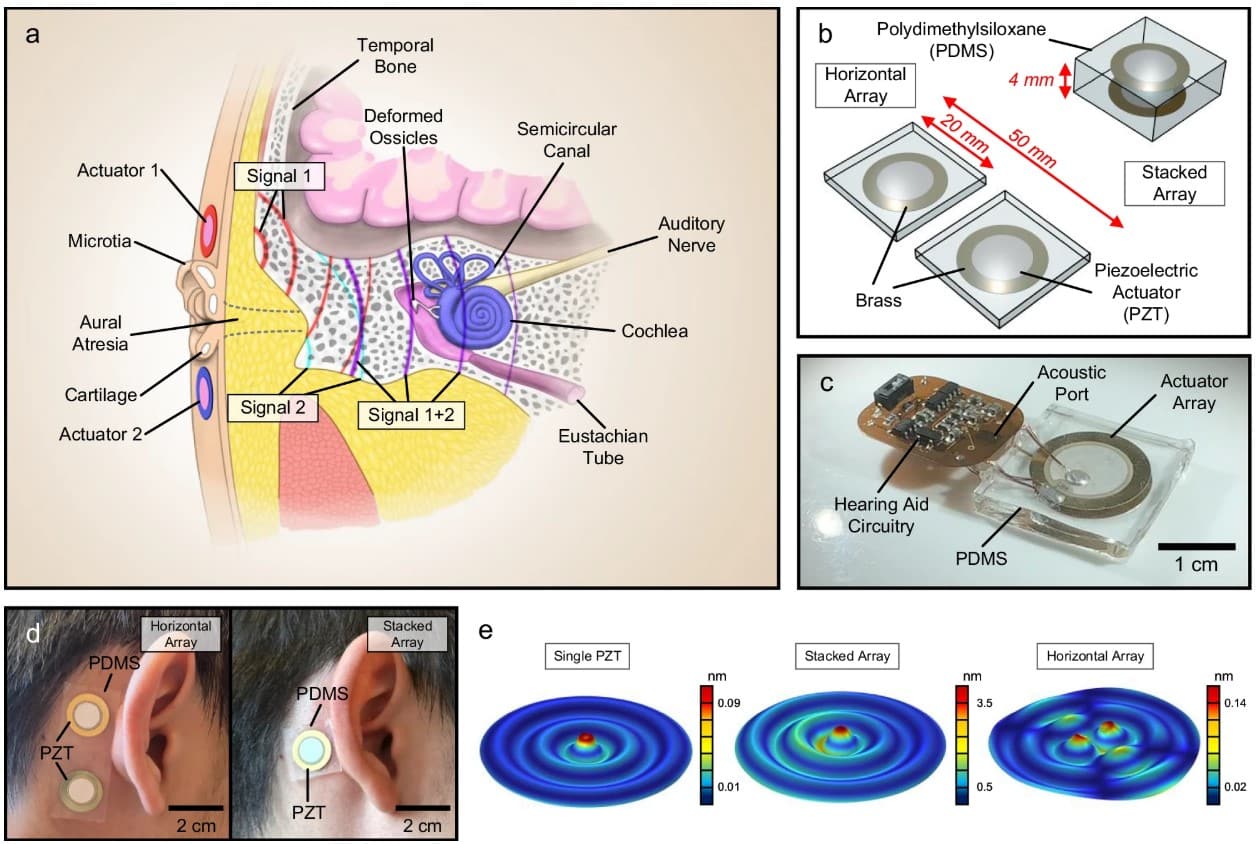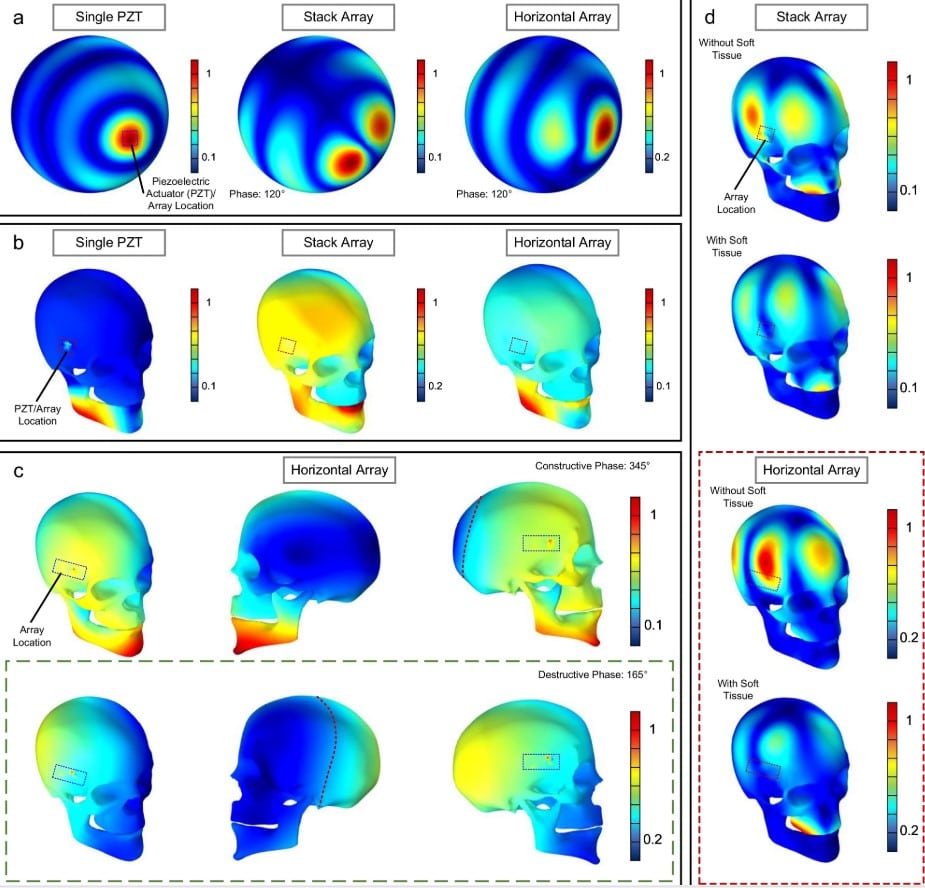Conductive hearing loss (CHL) in children presents unique challenges and is often managed through surgical interventions or external hearing devices. Conventional approaches, including bone-anchored hearing aids and corrective surgeries, can be effective but may involve multiple surgical procedures, continuous device upkeep, and potential challenges such as skin irritation and discomfort.
A new study published in Communications Engineering explores an innovative, noninvasive alternative: flexible conductive hearing aids that use micro-epidermal actuators (MEAs) to deliver sound through bone conduction. Researchers at Wake Forest University and the University of Illinois have developed and tested an array of these actuators, demonstrating significant improvements in sound transmission and hearing thresholds.
How the Technology Works
Flexible conductive hearing aids work by generating vibrations on the skin behind the ear, which are then transmitted to the skull and cochlea—bypassing the middle ear entirely. This approach eliminates the need for external devices that require constant repositioning or surgical implantation.
The core of this innovation is the micro-epidermal actuator (MEA), a thin, flexible transducer made of piezoelectric material. Unlike traditional devices, which rely on a single mechanical transducer, this new design incorporates an array of actuators, strategically arranged to enhance vibration transmission.
The research team designed two different MEA configurations:
- Horizontal arrays, which position the actuators side by side to maximize surface area.
- Stacked arrays, where actuators are vertically layered to amplify vibrational strength.
By optimizing these configurations, researchers aimed to increase the strength of vibrations while allowing greater control over sound directionality.

(a) Illustration of a horizontal actuator array applied to a patient with aural atresia. The actuators generate vibrational signals that constructively interfere within the bone, creating a stronger signal. The cochlea detects the combined vibrations and transmits the auditory signal to the brain. (b) Schematic representation of both horizontal and stacked actuator arrays embedded in flexible substrates. (c) A single-phase hearing aid device incorporating a stacked actuator array. (d) Photographs of human subjects wearing different actuator array configurations. (e) Finite Element Analysis (FEA) simulation of a single actuator and array configurations on a 100 mm radius, 3 mm thick bone at 7 kHz. The deformation is mapped based on displacement magnitude. While single PZT and stacked arrays generate symmetrical outward-propagating waves, the horizontal array produces vibrations with constructive and destructive interference patterns across the bone disk. Image credit: Lim, E., Redleaf, M. & Moghimi, M.J. (2025)
Experimental Findings: Improved Hearing Thresholds
The effectiveness of the flexible hearing aid was tested in a human subject study, which simulated conductive hearing loss by having participants wear earplugs and earmuffs. Subjects were fitted with the flexible hearing aid, and their hearing thresholds were measured.
Key findings include:
- The MEA array improved hearing thresholds by an average of 13.8 dB at 500 Hz compared to a single actuator.
- When using two actuators, participants experienced a 30.5 dB improvement at 1 kHz and a 20.5 dB improvement across frequencies ranging from 250 Hz to 8 kHz.
- Participants noted clearer sound quality and the ability to perceive quieter sounds, such as ambient noise in the room.
- The arrayed system reduced the voltage required to drive the actuators by 71%, making the device more energy efficient.
These results suggest that a multi-actuator approach not only enhances sound perception but also reduces the power demands of the device—an important consideration for practical, long-term use.

(a) Finite Element Analysis (FEA) simulation of a single PZT actuator and actuator arrays on a 14 cm diameter, 3 mm thick bone shell at 6 kHz. The inclusion of a second actuator in both horizontal and stacked arrays results in mode changes in the vibration patterns. (b) Comparison of a single PZT actuator and actuator arrays on a human skull at 600 Hz. The actuator arrays distribute vibrations across a larger surface area, enhancing signal propagation. (c) Vibration patterns of a horizontal array applied to a human skull at 250 Hz, highlighting constructive (top) and destructive (bottom) interference effects. Vibrations at the jaw were attenuated, while signal transmission to the back of the head was improved. (d) Vibration propagation on a human skull with and without soft tissue layers (skin, cerebrospinal fluid (CSF), and brain) at 7 kHz. The presence of soft tissue reduces vibration strength and alters the distribution of vibration modes. Image credit: Lim, E., Redleaf, M. & Moghimi, M.J. (2025)
Implications and Future Directions
This study marks a significant step forward in the development of noninvasive, pediatric-friendly hearing aids. The use of flexible MEA arrays offers several advantages:
- Noninvasive and Comfortable – Unlike surgically implanted solutions, this device adheres to the skin without the need for headbands or external anchoring.
- Improved Sound Transmission – The MEA arrays enhance vibration strength, making sound transmission more effective.
- Customizable Directionality – Phase control technology allows the device to direct vibrations toward either ear, which could be particularly useful for patients with unilateral hearing loss.
- Lower Power Consumption – The reduced voltage requirement makes this solution more energy-efficient, extending battery life.
The researchers plan to continue refining this technology by improving electronic circuits, adding user-controlled gain adjustments, and integrating a frequency equalizer for better sound quality. Additionally, larger clinical trials are needed to validate these findings in children with congenital conductive hearing loss.
A Promising Future for Noninvasive Hearing Aids
For children with conductive hearing loss, early intervention is critical for speech and language development. This study provides strong evidence that flexible hearing aids with MEA arrays could become a viable, noninvasive alternative to traditional solutions. By offering enhanced sound transmission, comfort, and energy efficiency, this technology represents a promising advancement in pediatric hearing care.
As hearing aid technology continues to evolve, innovations like these bring hope to families seeking better, less invasive solutions for their children’s hearing health.
Reference:
Lim, E., Redleaf, M. & Moghimi, M.J. Array of micro-epidermal actuators for noninvasive pediatric flexible conductive hearing aids. Commun Eng 4, 28 (2025). https://doi.org/10.1038/s44172-025-00369-7






